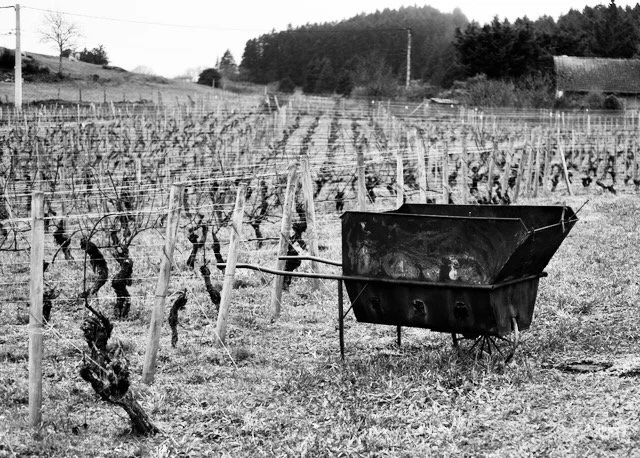Liquid History--Gamay from 1878
My questionable rental car GPS sent me through the steep and narrow back street of Renaison, requiring me to squeeze between stone walls, awkwardly parked cars, and pedestrians returning home with their baguette. Eventually, I emerged into the open hillside above town, with an expansive view of Roanne in the distance, and in the mist beyond that, Beaujolais.
This was one of my last stops on my two-week expedition across France and Spain in January. I was feeling worn down after 1200 miles of road behind me, but pulling up to the long gravel drive at Domaine de la Paroisse felt a bit like coming home - or at least like arriving at your favorite uncle and aunt's house. Laetitia Chaucesse was there to greet me with a big smile and a welcome offer to stretch my legs with a walk through the vineyards.
Jean-Claude and Laetitia had just returned the day before from a much earned two week vacation to Mexico. Despite my protest that they would want a day or two to recover, they insisted that I come by. Even with travel mishaps, delayed flights and jet-lag, the two of them were already back to work, because the truth is that even in the midst of winter, work hardly ever stops in the vineyard. Besides pruning, and cellar work, there are the long term project— the plans for incremental improvement that have slowly shaped this piece of land for 13 generations of the Chaucesse family.
We found Jean-Claude in the upper terraces of vineyards, busy directing an excavator operator, clearing land, and prepping soils for future planting. It will be the newest addition of vines, right alongside their oldest, the remarkable plot of Gamay planted in 1878 by Jean-Claude’s great-great-grandfather, still producing wine at 147 years old. With the energy of a man half his age, Jean-Claude hopped down from the excavator, greeted me warmly and declared “Let’s go taste some wine!”
We spent a frigid hour in the cellars, tasting through the wines still in barrel and tank, then moved inside, to the kitchen table, where we warmed up, and tasted through wines in bottle. Along with a meal of tender pork, soft buttery potatoes, and the obligatory array of local cheeses, Jean-Claude tasted me through 5 vintages, and we both concluded, that along with the 2019 vintage, 2023 might be some of the best wine he’s made—consolation for a disastrously small 2024 vintage. So before I left the next morning, I begged Laetitia for all she could spare of the 2023 vintage of this wine, the incomparable 1878.
• Domaine de la Paroisse ‘Cuvée 1878’ 2023 •
Old vineyards are a living museum, and Domaine de la Paroisse hosts an unparalleled exhibit; 147-year-old gamay vines planted immediately following the phylloxera epidemic. Jean-Claude believes that these may be the oldest grafted vines in France. Hunkering close to the ground, about 8 branches stemming from each trunk, producing about a dozen perfect clusters each year. La Paroisse only produces a few thousand bottles every vintage, and we greedily ask for as much as they will give us.
The 2023 vintage is an exceptional example, with balance, poise, real energy, and pure concentrated gamay fruit. It opens with beautiful dark fruit of plum, black cherry and a hint of baking spice. The mid-palate is dense and juicy, the finish mineral and lasting. In a word, this wine is complete. There won't be much of this from the following vintage, so don’t miss out on this one.

